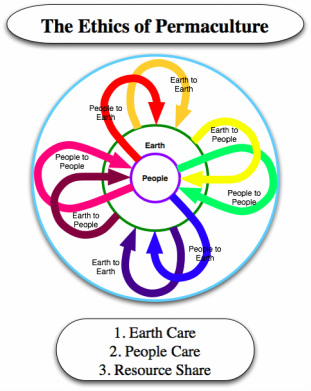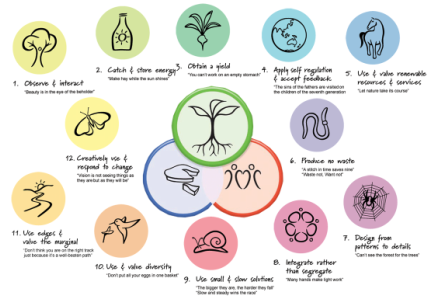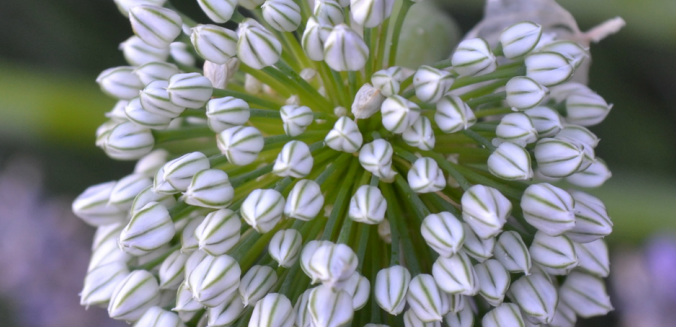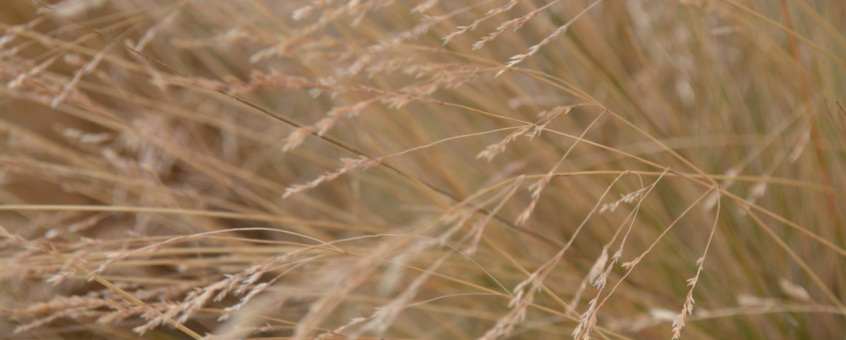About Permaculture
permaculture
ˈpəːməkʌltʃə/
noun
noun: permaculture
Derived from ‘Permanent’ and ‘Culture’, as follows:
Permanent: From the Latin permanens, to remain to the end, to persist throughout (per = through, manere = to continue)
Culture: From the Latin cultura - cultivation of land, or the intellect. Now generalized to mean all those habits, beliefs, or activities than sustain human societies.
Thus, Permaculture is the study of the design of those sustainable or enduring systems that support human society, both agricultural & intellectual, traditional & scientific, architectural, financial & legal. It is the study of integrated systems, for the purpose of better design & application of such systems.
ˈpəːməkʌltʃə/
noun
noun: permaculture
Derived from ‘Permanent’ and ‘Culture’, as follows:
Permanent: From the Latin permanens, to remain to the end, to persist throughout (per = through, manere = to continue)
Culture: From the Latin cultura - cultivation of land, or the intellect. Now generalized to mean all those habits, beliefs, or activities than sustain human societies.
Thus, Permaculture is the study of the design of those sustainable or enduring systems that support human society, both agricultural & intellectual, traditional & scientific, architectural, financial & legal. It is the study of integrated systems, for the purpose of better design & application of such systems.
Permaculture is a philosophy of working with, rather than against nature; of protracted & thoughtful observation rather than protracted & thoughtless labour; & of looking at plants & animals in all their functions, rather than treating any area as a single-product system.
Bill Mollison

Ethics
Neatly summed up as "Earth care, people care, fair shares", the permaculture ethics give purpose to our work, and connect us with the many millions of others who are also working towards a fairer, healthier and more harmonious human culture.
1. CARE OF THE EARTH: Provision for all life systems to continue and multiply.
Permaculture works with natural systems, rather than in competition with them. It uses methods that have minimal negative impact on the Earth’s natural environment. In everyday life, this may involve buying local produce, eating in season, and cycling rather than driving. Its about choices we make, and how we manage the land. Its about opposing the destruction of wild habitats, and the poisoning of soil, water and atmosphere, and its about designing and creating healthy systems that meet our needs without damaging the planet.
2. CARE OF PEOPLE: Provision for people to access those resources necessary to their existence.
As a part of this planet, you matter! This is about ensuring the wellbeing of both individuals and communities. As individuals, we need to look after ourselves and each other so that as a community we can develop environmentally friendly lifestyles. In the poorest parts of the world, this is still about helping people to access enough food and clean water, within a safe society. In the rich world, it means redesigning our unsustainable systems and replacing them with sustainable ones. This could mean working together to provide efficient, accessible public transport, or to provide after-school clubs for kids. When people come together, friendships are formed and sustainability becomes possible.
3. SETTING LIMITS TO POPULATION AND CONSUMPTION: By governing our own needs, we can set resources aside to further the above principles. Setting limits to population is not about limiting people's free movement, tight border controls and a one child policy. Its about working to achieve a stable human population, using a number of key strategies. These include: access to family planning; helping people to meet their basic needs of clean water, adequate food, and basic healthcare and education; education for girls.
The third ethic recognises that:
a. The Earth’s resources are limited.
b. These resources need to be shared amongst many beings.
Permaculture seeks to divide these resources fairly amongst people, animals and plants alike, not forgetting future generations who will need food, water and shelter just as much as we do now. Its 'one planet living'.
Neatly summed up as "Earth care, people care, fair shares", the permaculture ethics give purpose to our work, and connect us with the many millions of others who are also working towards a fairer, healthier and more harmonious human culture.
1. CARE OF THE EARTH: Provision for all life systems to continue and multiply.
Permaculture works with natural systems, rather than in competition with them. It uses methods that have minimal negative impact on the Earth’s natural environment. In everyday life, this may involve buying local produce, eating in season, and cycling rather than driving. Its about choices we make, and how we manage the land. Its about opposing the destruction of wild habitats, and the poisoning of soil, water and atmosphere, and its about designing and creating healthy systems that meet our needs without damaging the planet.
2. CARE OF PEOPLE: Provision for people to access those resources necessary to their existence.
As a part of this planet, you matter! This is about ensuring the wellbeing of both individuals and communities. As individuals, we need to look after ourselves and each other so that as a community we can develop environmentally friendly lifestyles. In the poorest parts of the world, this is still about helping people to access enough food and clean water, within a safe society. In the rich world, it means redesigning our unsustainable systems and replacing them with sustainable ones. This could mean working together to provide efficient, accessible public transport, or to provide after-school clubs for kids. When people come together, friendships are formed and sustainability becomes possible.
3. SETTING LIMITS TO POPULATION AND CONSUMPTION: By governing our own needs, we can set resources aside to further the above principles. Setting limits to population is not about limiting people's free movement, tight border controls and a one child policy. Its about working to achieve a stable human population, using a number of key strategies. These include: access to family planning; helping people to meet their basic needs of clean water, adequate food, and basic healthcare and education; education for girls.
The third ethic recognises that:
a. The Earth’s resources are limited.
b. These resources need to be shared amongst many beings.
Permaculture seeks to divide these resources fairly amongst people, animals and plants alike, not forgetting future generations who will need food, water and shelter just as much as we do now. Its 'one planet living'.

Principles
Permaculture principles provide a set of universally applicable guidelines that can be used in designing sustainable systems.
These principles are inherent in any permaculture design, in any climate, and at any scale. They have been derived from the thoughtful observation of nature, and from earlier work by ecologists, landscape designers and environmental science.
The principles have recently been reviewed by David Holmgren (one of the co-originators of permaculture) in his bookPermaculture: Principles and Pathways Beyond Sustainability. We have decided to use this new set as a way of presenting more in-depth information and examples. We make links and connection to previous principles and show how they combine to create a powerful new way to think about our interaction with the world.
Photo curtesy of Holmgren Design Services
- 1. Observe and Interact
"Beauty is in the eye of the beholder"
Observation is key to permaculture. Developing good observation skills is essential if we want to make well-functioning permaculture designs.
By observing natural and social patterns we are able to use them in our design work - this relates to Bill Mollison's philosophy of 'work with nature, not against'. We have to know how nature works if we want to be able to work with it.
"Good design depends on a free and harmonious relationship between nature and people, in which careful observation and thoughtful interaction provide the design inspiration." David Holmgren
Since we are usually dealing with complex systems - even a small garden can be incredibly diverse with many interactions - this principle suggests that we take a relatively cautious approach, that we make the smallest intervention that we think is necessary to make the change we want, and then closely observe the results. That way we can change, stop, or continue, depending on the results, without causing any big problems.
In fact, "failure", is very useful, as long as we learn! And learning is the key point. This principle reminds us that permaculture is all about learning. Permaculture uses an 'action learning' approach which works in stages:
1. We state a problem, issue or challenge
2. Then consider realistic options for action
3. Put the best option into action
4. Observe the results
5. Reflect on what has been learnt
6. Restate the problem, challenge or issue as it now is, and start a new phase of learning
Just observing makes nothing happen. Just acting can make problems bigger and bigger. We need to balance the two.
- 2. Catch and Store Energy
"Make hay while the sun shines"
This principle deals with the capture and storage of energy, within the environment, buildings and even society. If you think about a bank account, this principle is about how we can make our capital bigger, rather than how we spend the interest.
The vast majority of energy is supplied by the sun which is then captured by plants who have learnt the clever trick of how to turn photons into complex carbohydrates. This basic trick drives the whole planet's ecosystem. We need to rebuild 'natural capital' in order to create the basis for a long-term sustainable society.
Storing energy in the landscape
As permaculture designers we are helping to arrange our landscapes to maximise this energy capture. This is mainly by planting and nurturing new areas of 'biomass' - living things - mainly plants, usually as trees, woodlands, forest gardens, meadows, ponds, etc. Wherever possible we are also seeking to ensure that plant systems contribute to the development of deep healthy soils. Deep soils allow good crops, retain more rainfall, and also have the hugely important role of being the world's largest and most important living stores of carbon.
One advantage we have over nature is that we can also plan and decide how to catch energy in the landscape by storing it in dams, ponds and reservoirs, that can be used to do useful work for us.
Catching and storing energy in our built environment
We can design our buildings to catch energy too. Passive solar techniques are used to face buildings towards the sun, so that sunlight can help heat homes and provide light for free. Active solar technologies like solar photovoltaics and solar water heating can also catch the sun's energy and store it in well insulated water tanks and batteries.
You can store energy in the household too
Examples include preserved fruit and veg, wines and beers, a wood pile for winter fuel, a diverse seed box for the next growing season
- 3. Obtain a Yield
"You can't work on an empty stomach"
This principle is like an order. Make sure that every time you design a house, garden, park, or school, it includes elements that will provide real tangible yields. The yields could be food, fibres, or fuels, but there needs to be something. It is crazy to live in settlements where the only food source is the shop, and to get to the shop you pass gardens and parks, filled up with ornamental plants and gravel.
Permaculture stresses self-reliance - the ability to meet many of our own needs from our own resources. In a high rise flat that might be a window box with lettuces, as a whole community it may be the majority of our food. We can no longer rely on global food systems to meet our needs, or on there always being enough fossil fuels to bring the crops to us.
Permaculture stresses the use of plants that are functional - food medicine, fibres, but this doesn't mean boring or dull. Functional designs and plantings can also be beautiful - another important yield.
As Bill Mollison says: "The yield of a system is theoretically unlimited, or, limited only by the information and imagination of the designer." Put another way, 'obtain a yield' is not something we do once, but rather an approach to how we run our homes and design our settlements. Its a creative process and means that we are always looking to see how we can make an improvement here, add another species there.
With high yielding homes and settlements, we can meet our needs with less land. Then we can give some back to the many other species that are currently being 'squeezed out' by our current energy and land intensive agricultural systems.
- 4. Apply Self-regulation and Accept Feedback
"We reap what we sow"
This principle deals with the self-regulatory aspects of permaculture that limit or discourage inappropriate actions and behaviours. An obvious example of this is that permaculture has a set of ethics that aim to regulate how permaculture designers and practitioners behave, in particular that we accept limits to our consumption so that we do not take more than the earth is able to provide.
Self-maintaining systems are the 'holy grail' of permaculture, and can be seen in designs for forest gardens, in which work is minimised by planting ground covers to reduce weeds, nitrogen fixers to replace fertilisers and perennial and self-seeding plants to reduce annual plantings.
This is a work in progress and we are very keen to hear about your designs and systems.
- 5. Use and Value Renewable Resources and Services
"Let nature take its course"
Permaculture design aims to make best use of renewable resources to create, manage and maintain high yielding systems, even if some non-renewable resources are needed to establish the system in the first place.
As societies we need to value 'ecosystem services' such as water purification much more highly. Currently we are destroying natural ecosystems that would provide us with many thousands of years good service if we were to treat them with more respect.
Permaculture makes use of natural processes and animal behaviours as part of a design.
We need to understand the renewable resource we are using to ensure appropriate use, e.g. how many trees can we take from a woodland without damaging it? Harvesting of wild plants and animals can be part of the overall yield of a system.
Wind, sun and waves are key renewable resources that can help us move towards sustainability. Recreating forests and soils are two of the most important tasks of the twenty first century.
- 6. Produce no Waste
"Waste not want not", "A stitch in time saves nine"
Waste is just an unused output. If the output is unusable, or downright dangerous, we probably shouldn't be producing it in the first place (plutonium for example).
Permaculture aims to connect inputs and outputs so that different elements meet each other's needs. For example, if I save my kitchen waste and put it into a compost bin, I can make compost that can then be used to grow crops which I can then eat. I have saved waste (kitchen scraps that produce methane in landfill sites, and need transport to get it there), reduced external inputs (I don't need to buy compost) and increased yields (better soil, more crops, more worms.)
Careful maintenance and investing in good quality long lasting products can also help reduce waste and overall consumption levels.
As they say "refuse, reduce, reuse, repair, recycle". We could add re-design in there too, which is where permaculture makes its biggest contribution.
- 7. Design from Patterns to Details
"Can't see the woods for the trees"
The patterns found in the natural world are a source of inspiration for permaculture. 'Pattern thinking' can be used in a wide variety of situations, unlike specific techniques which can only be used in particular situations. Permaculture aims to help you think about the overall pattern for a project by using a variety of design methods. The principles themselves are all about helping to do this. Its about looking at the 'big picture' first.
The biggest picture thinking all relates to what we are trying to achieve, which is where the ethics come in.
Zoning is a very good example of a design method that is used to help generate an overall pattern for the site and ensure that it is designed to be energy efficient. Sector analysis is another design method used to see how energy (sun, wind, wildlife, etc) flows through a site. Both of these tools help to give an overall shape to the design, before getting too carried away with the specific details to start with.
When designing it is important to gain an understanding of the local / regional patterning:- landscape type, including hydrology
- underlying geology
- local biodiversity and common habitats
- social and cultural patterns - traditions, norms and values
- 8. Integrate rather than Segregate
"Many hands make light work"
One of the most important insights from ecology is that the relationships between things are as important as the things themselves. A healthy vibrant ecosystem is a mass of connections and relationships. That's what we are trying to create with a permaculture system.
Permaculture seeks to integrate elements together so that the needs of one are supplied by another. This is well described by three earlier principles:
Each important function is supported by many elements
For example, food for a household might be provided by a diversity of main crops, wild food, salad and vegetable beds, orchards and soft fruit, agreements with other producers, small and large livestock. If any one source fails, others will provide. This increases the systems 'resilience' and makes failure or disaster less likely.
Each element provides many functions
Many conventional and industrial systems tend to look at 'elements' (e.g. a chicken) as producing only one yield (eggs or meat). This single yield is then promoted and extended often at a cost to the environment and the element itself. In a permaculture system we are trying to utlise all the different functions and yields of an element, e.g. a chicken can provide pest control, tillage, meat, feathers, eggs, heat etc., to increase the overall yields and create a more integrated system.
Relative location
In order for there to be good connections between different parts of the system, it is important to place them so that they can do this. An obvious example is that a rainwater collection barrel is generaly best placed next to the downpipe from a house, or chickens next to annual beds that need occassional tilling and pest control, or herbs next to the back door for easy picking for your next cup of tea!
- 9. Use Small and Slow Solutions
"The bigger they are the harder they fall", "Slow and steady wins the race"
This reminds us that systems should be designed to function at the smallest scale that is practical and energy efficient (rather than the biggest). In some ways this is a value judgement. Permaculture favours small scale and local, over big scale and global. Usually.
This links to concepts like 'human scale' as Kirkpatrick Sale calls it, and the ideas of Fritz Schumacher in his book 'Small is Beautiful'.
Small scale solutions and activities are more likely to be adaptive to local needs, respectful of nature and able to see the consequences of actions. Slow food, slow cities, slow down! Incremental changes can be more easily understood and monitored.
This concept links to one of the "Golden Rules" from Bill Mollison's Designers Manual - start small, get it under control and then slowly expand the perimeter - or put another way, don't take on too much too quickly, as you are likely to be overwhelmed.
- 10. Use and Value Diversity
"Don't put all your eggs in one basket"
Diversity is the very essence and joy of life. Maintaining and enhancing the diversity of existing eco-systems is essential for so many reasons. Preserving and protecting what little wilderness we have left is one of most important tasks. But in permaculture we don't stop there.
Wherever possible our designs always incorporate a 'zone 5' area which is left for nature to do as it will. We also try to make use of nature friendly techniques and technologies to minimise harm.
Permaculture designs should always try to incorporate a wide variety of plants, animals and approaches. This is not just for the sake of it, but because diversity can act like an insurance policy - if one crop fails, another may succeed. Even within an orchard there will be a diversity of different varieties. Take apples as an example. A healthy diverse orchard will contain early flowering, late flowering, eaters, and cookers. If an early frost gets some, others will be popping out flowers later on.
Polycultures (agriculturral systems with many plants), are now proven to be more productive overall and resilient to weather, pests and other factors, than monocultures (agricultural systems with only one plant species.) Another good reason to understand and use diversity...
Plant diversity is also key to many useful techniques such as 'integrated pest management'.
Human diversity is also key to creativity and a vibrant, healthy human society.
- 11. Use Edges and Value the Marginal
"Dont' think you are on the right track just because it is a well beaten path"
The place where two eco-systems or habitats meet (e.g. woodland and meadow) is generally more productive and richer in the variety of species present than either habitat on its own. In ecology this is called 'ecotone'. This is central to the idea of using edges as a design method. The logic is simple. If the most productive bit of woodland is the edge, then design it to have a bigger edge.
These ideas are used in alley cropping, shelterbelts and pond design.
Marginal could be ideas, views, unusual plants, wild animals or people at the 'edge' of society. Permaculture itself has been seen as marginal for many years....
- 12. Creatively Use and Respond to Change
"Vision is not seeing things as they are, but as they will be"
We know things are changing - faster than we would like maybe. Climate change, peak oil, resource depletion, population growth, technology changes, economic booms and busts, all contribute to a less than certain age. Many of these challenges seem beyond our control. However, the way we think about them, and how we react as individuals, groups, organisations and networks, is under our control.
The other strand to this principle is planning and designing for known changes. For example, seasons of spring, summer, autumn and winter are predictable and can be planned for, and incorporated into our designs, management and action plans. How eco-systems change over time - in ecology this is called 'succession' is also predictable, at least overall. By understanding how ecosystems change over time, we can accelerate the process and create productive ecosystems faster than is usual in nature. Forest gardens are an example of this, where all the layers of the forest are put in all in one go, rather than over many years.
There are also many methods for social change, organisational development and community engagement that we can use to help groups work together and collectively plan for changes. Working with people is just as important in permaculture as working with plants (which are much easier!)


